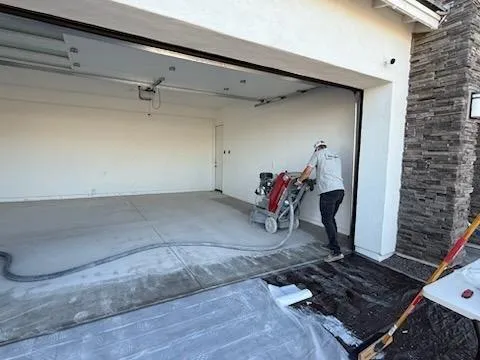
Epoxy vs. Polyaspartic: What’s the Difference and Why It Matters
Understanding the Basics
What Is Epoxy?
Epoxy is a resin-based coating created by mixing a resin with a hardener. Once applied, it forms a hard plastic surface that adheres to concrete. It has been widely used in residential and commercial applications for decades and is generally considered a durable and cost-effective solution. However, it comes with some limitations.
What Is Polyaspartic?
Polyaspartic is a more advanced coating technology that belongs to the same family as polyurethane. It was originally developed for industrial applications, but has become increasingly popular for residential and commercial use due to its superior performance, faster cure time, and durability in extreme environments.
Head-to-Head Comparison
Cure Time
- Epoxy: Requires between 2 to 5 days to fully cure, which limits access to the coated area.
- Polyaspartic: Fully cures in just one day, allowing for minimal disruption and faster project turnaround.
UV Resistance
- Epoxy: Susceptible to yellowing or chalking over time when exposed to direct sunlight.
- Polyaspartic: 100% UV-stable, making it ideal for Arizona driveways, patios, and other outdoor areas.
Durability
- Epoxy: Durable but brittle. It can crack or peel in high-temperature environments or when the concrete shifts.
- Polyaspartic: Up to five times stronger than epoxy and more flexible, allowing it to expand and contract with temperature changes without cracking.
Chemical Resistance
- Epoxy: Resistant to some chemicals, but can degrade when exposed to battery acid, brake fluid, or salt.
- Polyaspartic: Highly resistant to a wide range of harsh chemicals, including oil, salt, and cleaning agents.
Installation Conditions
- Epoxy: Requires very specific environmental conditions during installation, and isn’t ideal for cold or extremely hot weather.
- Polyaspartic: Can be installed in a broader range of temperatures, including the extreme heat and sun of Arizona.
Appearance and Finish
- Epoxy: Can appear glossy but often highlights imperfections. Solid colors show every blemish.
- Polyaspartic: Applied using a decorative flake system that not only hides imperfections but also improves texture and traction. The finish is clean, consistent, and more visually appealing.
What Makes Polyaspartic Stand Out
In addition to its technical advantages, polyaspartic coatings allow for more design flexibility. At Diamond Coatings AZ, for example, customers can choose from a wide range of flake colors and blends — all kept in stock and ready for quick installation.
Every project begins with proper surface preparation using an industrial diamond grinder. This step is essential to ensure long-term adhesion and finish quality, and it's often overlooked or done poorly in lower-cost installations.
Conclusion: Which Should You Choose?
Epoxy has long been a go-to option for concrete coating, but it’s quickly becoming outdated in environments that demand durability, visual appeal, and fast installation. For Arizona homes and businesses dealing with high heat, UV exposure, and constant wear, polyaspartic coatings offer a more reliable, longer-lasting solution.
At Diamond Coatings AZ, we install polyaspartic systems using a proven 3-layer flake application process, backed by a lifetime warranty. Whether you're upgrading your garage, resurfacing a pool deck, or sealing a commercial space, we ensure your floor looks great and performs for years to come.
Interested in upgrading your space with a polyaspartic floor system?
Request your free estimate today.